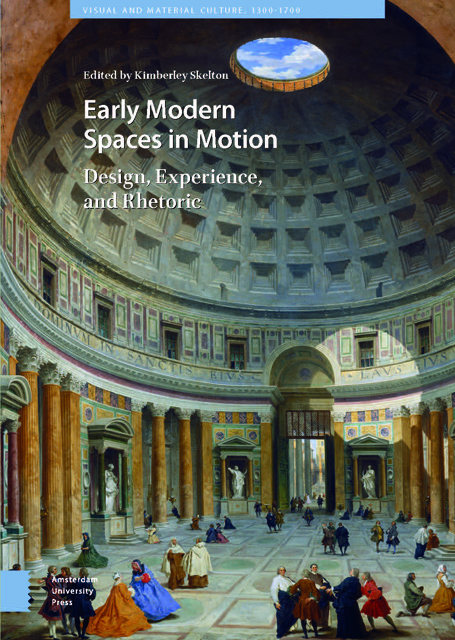Book contents
- Frontmatter
- Table of Contents
- List of Illustrations
- Acknowledgements
- Introduction: Bodies and Buildings in Motion
- 1 Navigating the Palace Underworld : Recreational Space, Pleasure, and Release at the Castello del Buonconsiglio, Trent
- 2 Passages to Fantasy : The Performance of Motion in Celliniâs Fontainebleau Portal and the Galerie François I
- 3 The Catholic Country House in Early Modern England : Motion, Pietyand Hospitality, c. 1580â1640
- 4 Sensory Vibrations and Social Reform at San Michele a Ripa in Rome
- 5 The Rise of the Staircase: Motion in Eighteenth-Century Dutch Domestic Architecture
- 6 Movement through Ruins: Re-experiencing Ancient Baalbek with Jean de la Roque
- 7 A Paper Tour of the Metropolis : The Architecture of Early Modern London in the Royal Magazine
- 8 Libraries in Motion: Forms of Movement in the Early Modern Library (1450-1770)
- Works Cited
- Index
4 - Sensory Vibrations and Social Reform at San Michele a Ripa in Rome
Published online by Cambridge University Press: 11 January 2023
- Frontmatter
- Table of Contents
- List of Illustrations
- Acknowledgements
- Introduction: Bodies and Buildings in Motion
- 1 Navigating the Palace Underworld : Recreational Space, Pleasure, and Release at the Castello del Buonconsiglio, Trent
- 2 Passages to Fantasy : The Performance of Motion in Celliniâs Fontainebleau Portal and the Galerie François I
- 3 The Catholic Country House in Early Modern England : Motion, Pietyand Hospitality, c. 1580â1640
- 4 Sensory Vibrations and Social Reform at San Michele a Ripa in Rome
- 5 The Rise of the Staircase: Motion in Eighteenth-Century Dutch Domestic Architecture
- 6 Movement through Ruins: Re-experiencing Ancient Baalbek with Jean de la Roque
- 7 A Paper Tour of the Metropolis : The Architecture of Early Modern London in the Royal Magazine
- 8 Libraries in Motion: Forms of Movement in the Early Modern Library (1450-1770)
- Works Cited
- Index
Summary
Abstract
From the mid-seventeenth century, philosophical arguments about human responses to the physical environment challenged a basic tenet of prison design and administration: that prisoners could use reason to apply religious instruction towards reconsidering their criminal ways. Mechanistic philosophers asserted that humans reacted physically and psychologically on impulse to neural vibrations that were produced by sensory stimuli in their environment and that traversed their bodies and brains. Correspondingly, prison designers and administrators recrafted prisons into reform environments that used sensory cues to choreograph human physical and psychological processes and, in turn, reshape social behavior. This essay examines the early stages of such new prison design by turning to Rome, especially Carlo Fontana’s Casa di Correzione for juvenile delinquents.
Keywords: prison, juvenile delinquents, sensory perception, Rome, Foucault
In 1704, foreign dignitaries and members of Pope Clement XI’s papal court in Rome would have been surprised when they received and turned over his annual medal (Figure 18). Each year, the reigning pope commissioned a medal in gold, silver, and bronze with his profile on the front and a commemoration of a key event from the previous year on the reverse. The reverse of Clement XI’s 1704 medal showed the interior of the new Casa di Correzione, a prison for juvenile delinquents housed in the Ospizio di S. Michele a Ripa, and the interior was filled with movement. Boys laboured at workbenches and desks, guards and master craftsmen strolled among the workbenches to supervise the boys, and other guards watched and conversed from the balconies in front of the cells. Carlo Fontana, the architect of the Casa di Correzione and the designer of the medal, had even amplified these movements by adding well-dressed figures who walked around the workbenches to observe the prison’s daily life. So important were these movements, moreover, that the building itself was pushed to the margins of the medal. Only thin slivers of walls appear to left and right, just enough to note the three tiers of cells with their balustrades flanking the central space. Previous annual papal medals, in contrast, had commemorated new buildings by offering scenes emptied of people and so had showcased the architect’s design.
- Type
- Chapter
- Information
- Early Modern Spaces in MotionDesign, Experience and Rhetoric, pp. 111 - 138Publisher: Amsterdam University PressPrint publication year: 2020



